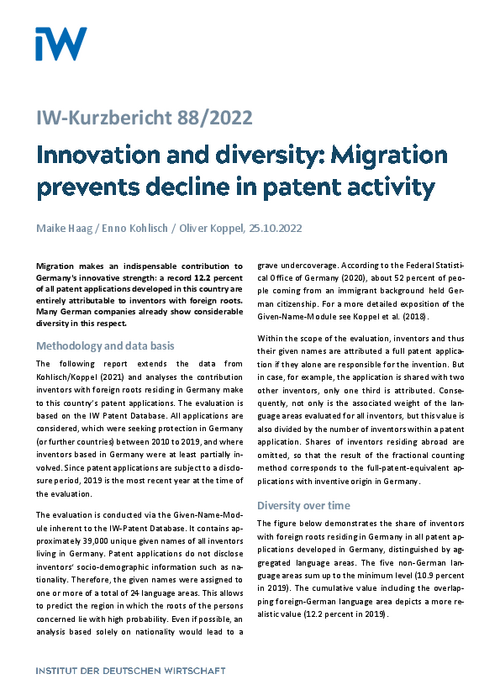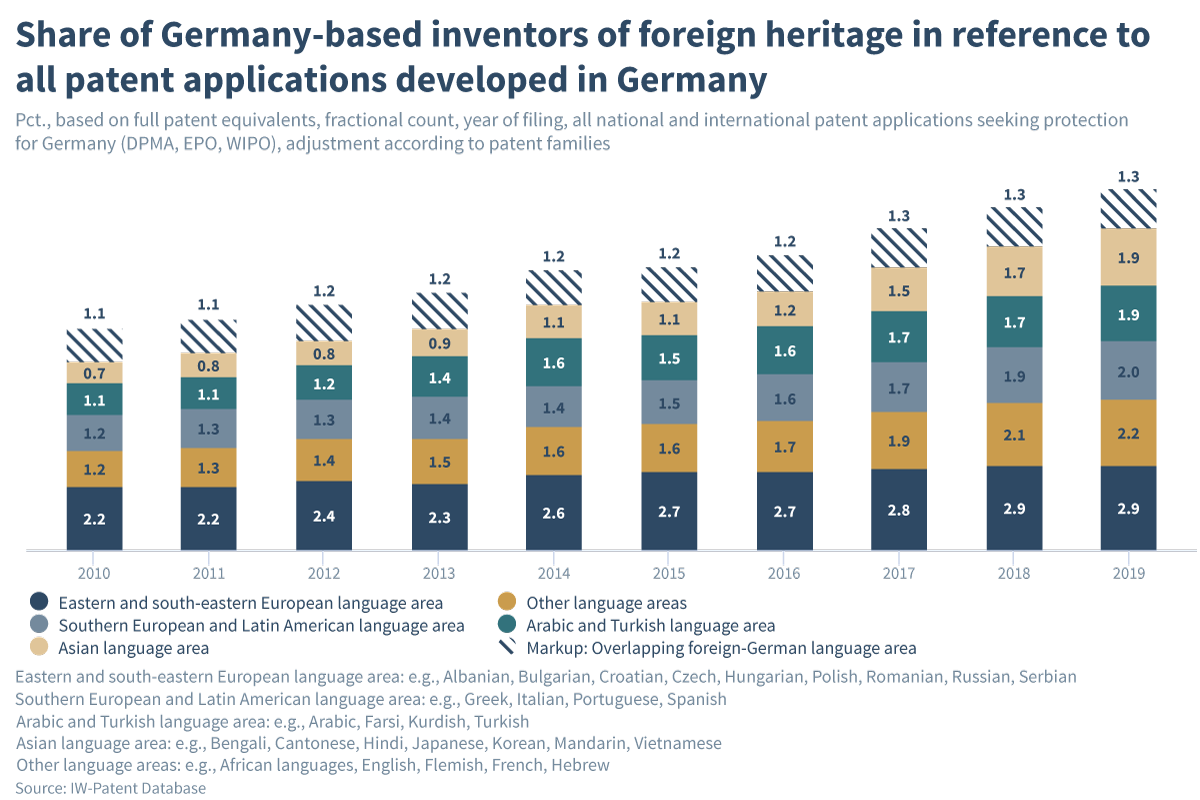Migration makes an indispensable contribution to Germany's innovative strength: a record 12.2 percent of all patent applications developed in this country are entirely attributable to inventors with foreign roots. Many German companies already show considerable diversity in this respect.

Innovation and diversity: Migration prevents decline in patent activity

Migration makes an indispensable contribution to Germany's innovative strength: a record 12.2 percent of all patent applications developed in this country are entirely attributable to inventors with foreign roots. Many German companies already show considerable diversity in this respect.
Methodology and data basis
The following report extends the data from Kohlisch/Koppel (2021) and analyses the contribution inventors with foreign roots residing in Germany make to this country’s patent applications. The evaluation is based on the IW Patent Database. All applications are considered, which were seeking protection in Germany (or further countries) between 2010 to 2019, and where inventors based in Germany were at least partially involved. Since patent applications are subject to a disclosure period, 2019 is the most recent year at the time of the evaluation.
The evaluation is conducted via the Given-Name-Module inherent to the IW-Patent Database. It contains approximately 39,000 unique given names of all inventors living in Germany. Patent applications do not disclose inventors‘ socio-demographic information such as nationality. Therefore, the given names were assigned to one or more of a total of 24 language areas. This allows to predict the region in which the roots of the persons concerned lie with high probability. Even if possible, an analysis based solely on nationality would lead to a grave undercoverage. According to the Federal Statistical Office of Germany (2020), about 52 percent of people coming from an immigrant background held German citizenship. For a more detailed exposition of the Given-Name-Module see Koppel et al. (2018).
Within the scope of the evaluation, inventors and thus their given names are attributed a full patent application if they alone are responsible for the invention. But in case, for example, the application is shared with two other inventors, only one third is attributed. Consequently, not only is the associated weight of the language areas evaluated for all inventors, but this value is also divided by the number of inventors within a patent application. Shares of inventors residing abroad are omitted, so that the result of the fractional counting method corresponds to the full-patent-equivalent applications with inventive origin in Germany.

Diversity over time
The figure below demonstrates the share of inventors with foreign roots residing in Germany in all patent applications developed in Germany, distinguished by aggregated language areas. The five non-German language areas sum up to the minimum level (10.9 percent in 2019). The cumulative value including the overlapping foreign-German language area depicts a more realistic value (12.2 percent in 2019).
Between 2010 and 2019 the share of Germany-based inventors of foreign heritage has continuously increased from 7.5 to 12.2 percent. All language areas have gained significantly in impact. About every eighth patent application developed in Germany was entirely attributable to inventors with foreign roots. And this contribution is essential for Germany's innovative strength. The cumulative patent output of inventors originating from the German-speaking region has stagnated since 2010 and has even fallen most recently. This is due to the demographic development and aggravated by the shortage of technological-scientific oriented employees (STEM) in the workforce. These occupations typically account for research and development and, thus, for patent applications.
In contrast, the cumulative number of patent applications developed in Germany by inventors with foreign roots increased by 76 percent between 2010 and 2019. The respective number for inventors with roots in Asian-speaking countries even rose by 179 percent - including Indian-speaking countries, whose numbers increased by as much as 380 percent.
In conclusion: The moderate increase in patent applications developed in Germany over the last ten years is exclusively due to inventors with foreign roots. Without them, Germany’s overall economic patent activity would have decreased. Especially, immigration of technical and scientific experts from non-EU countries has had a positive impact to strengthening Germany’s innovation capacity. These experts are the core group of potential inventors.
Results by applicant groups
Due to the full coverage of German applicants in the IW Patent Database, the results can be differentiated according to specific applicants and groups of applicants. In this section, the proportion of inventors with foreign roots is measured by the non-German language areas only, i.e., the minimum level of diversity. The comparative value for all applicants therefore is 10.9 percent. Many small businesses only hold one patent application and, thus, often achieve a ratio of 100 percent inventors of foreign heritage. To ensure quantitative relevance, the evaluation is limited to profit-oriented legal entities residing in Germany, which filed at least 50 patent applications in 2019. The current top 5 German companies in terms of diversity, measured by the percentage contribution of their inventors with foreign roots, are as follows:
- SAP SE: 54,5%
- Valeo Schalter und Sensoren GmbH: 40,9%
- Rolls-Royce Deutschland Ltd & Co. KG: 28,4%
- Continental Reifen Deutschland GmbH: 23,8%
- Rohde & Schwarz GmbH & Co. KG: 21,4%
Without its inventors with foreign roots, frontrunner SAP would suffer the loss of over half of its patent performance. For the above-mentioned companies, there is also an additional facet of diversity. Their inventors are not pooled in one certain area of origin but come from a variety of language areas.
Regarding independent inventors, i.e., natural persons concurrently representing applicant(s) and inventor(s), the reference value amounts to a considerable 11.9 percent.
Furthermore, the respective value for German non-/low-profit institutions can be determined. Due to the usually low number of patent applications per individual institution (university, institute, association, …), the values are stated in aggregate categories.
- Max Planck Society: 26,2%
- Leibniz Association: 24,1%
- Helmholtz Association (excl. KIT): 20,9%
- Institutions of tertiary education (incl. KIT): 13,4%
- Fraunhofer Society: 12,4%
- Other public or private non-/low-profits: 7,1%
The Max Planck Society claims first place, followed by the aggregate of the 23 patent-active institutes of the Leibniz Association and the 17 patent-active institutes of the Helmholtz Association. For a long time, these institutions have successfully pursued a strategy of internationalising its researching workforce in Germany.
The 118 patent-active institutions of tertiary education account for a share of 13.4 percent. Similar to the Fraunhofer Society (12.4 percent), this percentage is only slightly above the overall economic average. In the residual category of other public or private non-profit institutions, on the other hand, only one in 14 patent applications (7.1 percent) is filed by inventors with roots abroad.

Innovation and diversity: Migration prevents decline in patent activity

More on the topic

The Transformation of the Automotive Industry: An International Comparison of Germany's Innovation Performance
The automotive industry is undergoing a comprehensive technological transformation that is challenging established value chains. Making sure that domestic research helps to shape this ongoing transformation is therefore an important task for countries with a ...
IW
Innovation Atlas 2023: The innovative strength of the German regions
All indicators of innovative strength in Germany – from research intensity and scientific and technical employment structures to patent successes – point to a strong south-north, west-east and urban-rural divide.
IW